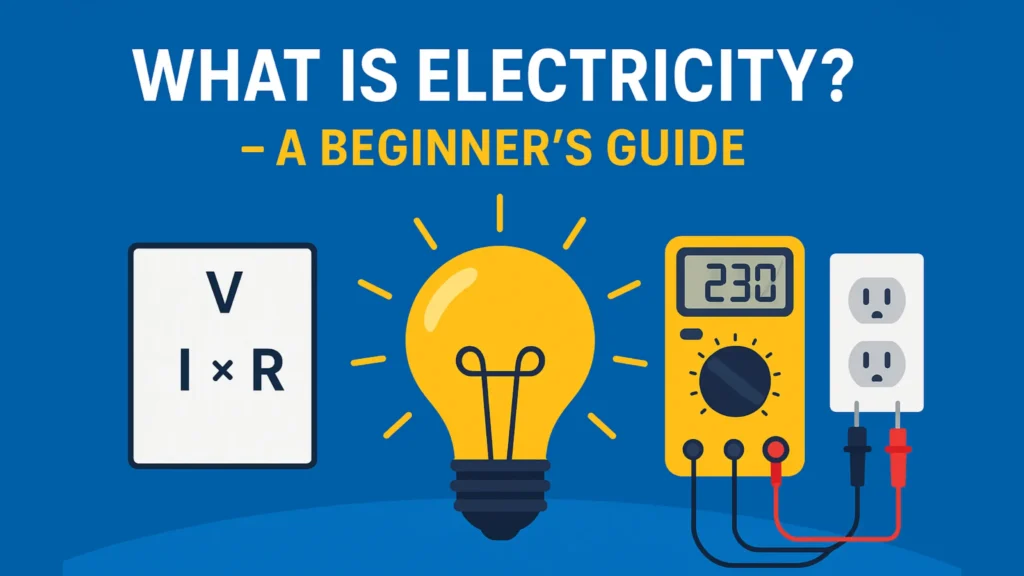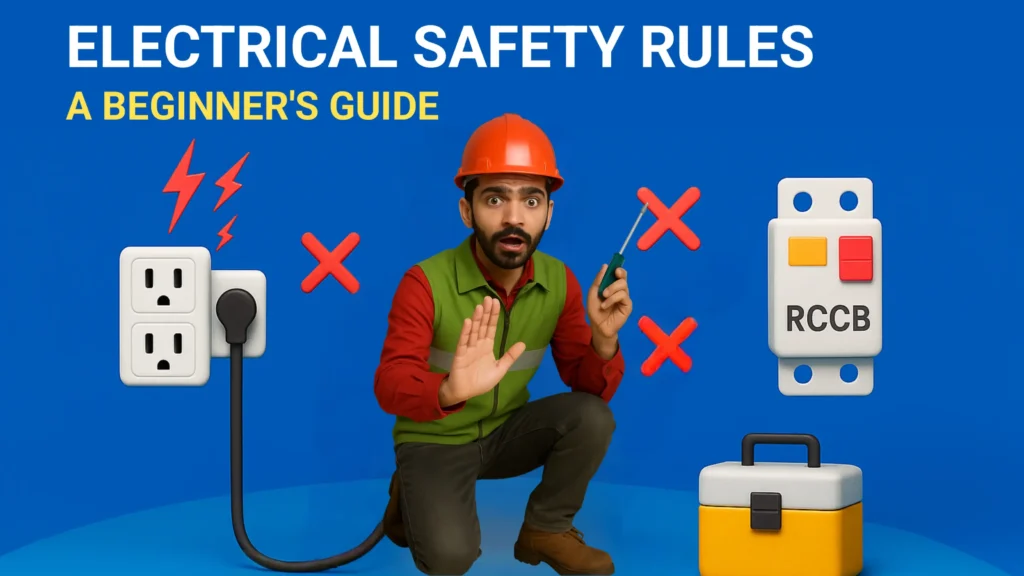
This beginner’s guide explains What is Electricity, how it works, and the key concepts of voltage, current, and resistance. It covers the difference between AC and DC, how electricity is generated, its everyday uses, and essential safety tips. The post introduces Ohm’s Law in simple terms, making it easy for new learners to start their electrical journey.
What is Electricity – A Beginner’s Guide
Electricity is one of the most essential parts of our modern life. From switching on a light to charging your phone, electricity powers almost everything around us. But exactly what is electricity, and how does it work?
In this beginner’s guide, we will break it down into simple concepts so you can understand it easily.
Definition of Electricity
Electricity is the flow of electric charge, usually carried by electrons moving through a conductor like a copper wire.
It is a form of energy that can be used to power electrical devices, machines, and appliances.
In short:
Electricity = Flow of charges (usually electrons) through a conductor.
The Three Main Elements of Electricity
To understand electricity, you need to know three important terms:
a) Voltage (V)
- Voltage is the “pressure” that pushes electric charges through a conductor.
- Measured in volts (V).
- Example: In India, most homes use 230V AC supply.
b) Current (I)
- Current is the amount of electric charge flowing through a conductor per second.
- Measured in amperes (A).
- Think of it like the flow rate of water in a pipe.
c) Resistance (R)
- Resistance is how much a material opposes the flow of electric current.
- Measured in ohms (Ω).
- Example: A thin wire has more resistance than a thick wire.
📌 Formula (Ohm’s Law):
V = I × R
👇 Ohm’s Law
Definition
Ohm’s Law states that the current (I) flowing through a conductor is directly proportional to the voltage (V) across it, and inversely proportional to the resistance (R) — provided the temperature remains constant.

Formula: V=I×RV = I \times RV=I×R
Where:
- V = Voltage (in volts, V)
- I = Current (in amperes, A)
- R = Resistance (in ohms, Ω)
Understanding in Simple Words
- If you increase the voltage, more current will flow.
- If you increase the resistance, less current will flow.
Example Calculation
If a circuit has:
- Voltage V=12VV = 12VV=12V
- Resistance R=6ΩR = 6ΩR=6Ω
Current: I=V/R=12/6=2A
So 2 amperes of current will flow.
Types of Electricity
There are two main types:
a) Direct Current (DC)
- Flows in one direction only.
- Examples: Batteries, Solar panels.
b) Alternating Current (AC)
- Changes direction periodically.
- Example: Power supply in homes and offices.
Difference between AC and DC – Current

💡 Tip to remember:
- AC = changes direction like waves 🌊 (used in homes & industries)
- DC = flows straight like a river 🏞 (used in electronics & batteries)
Here’s a clear and simple difference between AC (Alternating Current) and DC (Direct Current) in a table format so you can quickly understand:
| Feature | AC (Alternating Current) | DC (Direct Current) |
|---|---|---|
| Flow of Current | Changes direction periodically | Flows in one fixed direction |
| Waveform | Sine wave (can also be square or triangular in some cases) | Straight line (constant) |
| Frequency | In India: 50 Hz (changes direction 50 times per second) | 0 Hz (no frequency) |
| Source Examples | Power stations, household electricity | Batteries, solar panels |
| Transmission | Can be easily transmitted over long distances with less loss | Not suitable for long distances without conversion |
| Voltage Level | Can be stepped up or down using transformers | Voltage is fixed unless converted |
| Applications | Home appliances, industry power supply | Electronics, mobile devices, vehicles |
| Example Devices | Fans, refrigerators, washing machines | Mobile phones, laptops, flashlights |
How Electricity is Produced
Electricity can be generated in several ways:
- Thermal power plants (burning coal or gas)
- Hydropower plants (using flowing water)
- Wind turbines
- Solar panels
- Nuclear power plants
Uses of Electricity in Daily Life
- Lighting homes and streets
- Running appliances (fan, TV, fridge)
- Industrial machines
- Communication devices (mobiles, computers)
- Electric vehicles
Safety Tips for Beginners
- Never touch electrical wires with wet hands.
- Always turn off the main power before working on wiring.
- Use proper insulated tools.
- Install an MCB and RCCB for protection.
Summary
Electricity is simply the flow of charges that powers our daily life. Understanding voltage, current, and resistance is the first step in learning electrical work.
Once you understand the basics, you can move on to wiring, circuits, and practical applications. 👇👇👇
👇 If you found this guide helpful, share it with friends and explore other parts of our Electrical Learning Series to power up your knowledge.
⏬ Up Next in the Electrical Learning Series – Part 2
“Electrical Safety Rules for Beginners” – Before you touch a wire or pick up a tool, you must know the essential safety rules every beginner electrician should follow. This next guide will show you how to protect yourself, your tools, and your home while working with electricity.
Electrical Safety Rules for Beginners

Pingback: Electrical Safety Rules for Beginners – (Electrical Learning Series – Part 2) -
Pingback: Basic Electrical Tools and Their Uses : (Electrical Learning Series – Part 3) -
Pingback: Wiring Basics Introduction to House Wiring – Level 2 (Part 4) -
Pingback: 1-Way Switch Connection: Diagram, Step-by-Step Guide & Common Mistakes to Avoid - Home Fitting